-
TLV717P 150-mA, Low-Dropout Regulator With Foldback Current Limit for Portable Devices
- 1 Features
- 2 Applications
- 3 Description
- 4 Revision History
- 5 Pin Configuration and Functions
- 6 Specifications
- 7 Detailed Description
- 8 Application and Implementation
- 9 Power Supply Recommendations
- 10Layout
- 11Device and Documentation Support
- 12Mechanical, Packaging, and Orderable Information
- IMPORTANT NOTICE
Package Options
Mechanical Data (Package|Pins)
- DQN|4
Thermal pad, mechanical data (Package|Pins)
- DQN|4
Orderable Information
TLV717P 150-mA, Low-Dropout Regulator With Foldback Current Limit for Portable Devices
1 Features
See the Package Option Addendum at the end of this document for a complete list of available voltage options.See2 Applications
3 Description
The TLV717P series of low-dropout (LDO) linear regulators are low quiescent current LDOs with excellent line and load transient performance and are designed for power-sensitive applications. These devices provide a typical accuracy of 0.5%.
The TLV717P series offer current foldback that throttles down the output current with a decrease in load resistance. The typical value at which current foldback initiates is 350 mA; the typical value of the output short current limit value is 40 mA.
Furthermore, these devices are stable with an effective output capacitance of only 0.1 µF. This feature enables the use of cost-effective capacitors that have higher bias voltages and temperature derating. The devices regulate to specified accuracy with no output load.
The TLV717P series is available in a 1-mm × 1-mm DQN package that makes them ideal for hand-held applications. The TLV717P provides an active pulldown circuit to quickly discharge output loads.
Device Information(1)
| PART NUMBER | PACKAGE | BODY SIZE (NOM) |
|---|---|---|
| TLV717P | X2SON (4) | 1.00 mm × 1.00 mm |
- For all available packages, see the orderable addendum at the end of the data sheet.
Typical Application Circuit
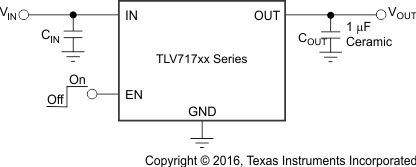
4 Revision History
Changes from A Revision (February 2012) to B Revision
- Deleted all instances of TLV717xx; Replaced with generic part number, TLV717PGo
- Updated Applications. Go
- Added ESD Ratings table, Feature Description section, Device Functional Modes, Application and Implementation section, Power Supply Recommendations section, Layout section, Device and Documentation Support section, and Mechanical, Packaging, and Orderable Information section Go
- Changed TJ = –25°C to TJ = 25°C in the conditions statement in Absolute Maximum RatingsGo
- Changed TA to TJ throughout Electrical CharacteristicsGo
- Changed TA to TJ in the conditions statement in Typical Characterisitcs Go
- Changed junction temperature range from –40°C to 125°C to –40°C to 85°C in OverviewGo
- Deleted TLV717xx functional block diagramGo
Changes from * Revision (October 2011) to A Revision
- Changed document status from Product Preview to Production DataGo
5 Pin Configuration and Functions


Pin Functions
| PIN | I/O | DESCRIPTION | |
|---|---|---|---|
| NAME | NO. | ||
| EN | 3 | I | Enable pin. Driving EN over 1.2 V turns on the regulator. Driving EN below 0.4 V puts the regulator into shutdown mode. |
| GND | 2 | — | Ground pin |
| IN | 4 | I | Input pin. A small capacitor is recommended from this pin to ground to assure stability. See the Input and Output Capacitor Requirements section in the Application and Implementation for more details. |
| OUT | 1 | O | Regulated output voltage pin. A small 1-μF ceramic capacitor is recommended from this pin to ground to assure stability. See the Input and Output Capacitor Requirements section in the Application and Implementation for more details. |
| Thermal pad | — | — | Connect to GND for improved thermal performance. |
6 Specifications
6.1 Absolute Maximum Ratings
At TJ = 25°C, unless otherwise noted. All voltages are with respect to GND.(1)| MIN | MAX | UNIT | ||
|---|---|---|---|---|
| Voltage | Input range, VIN | –0.3 | 6 | V |
| Enable range, VEN | –0.3 | VIN + 0.3 | ||
| Output range, VOUT | –0.3 | 6 | ||
| Current | Maximum output, IOUT | Internally limited | ||
| Output short-circuit duration | Indefinite | |||
| Continuous total power dissipation, PDISS | See Thermal Information | |||
| Temperature | Junction, TJ | –55 | 150 | °C |
| Storage junction, Tstg | –55 | 150 | ||
6.2 ESD Ratings
| VALUE | UNIT | |||
|---|---|---|---|---|
| V(ESD) | Electrostatic discharge | Human-body model (HBM), per ANSI/ESDA/JEDEC JS-001(1) | ±2000 | V |
| Charged-device model (CDM), per JEDEC specification JESD22-C101(2) | ±500 | |||
6.3 Recommended Operating Conditions
over operating junction temperature range (unless otherwise noted)| MIN | MAX | UNIT | ||
|---|---|---|---|---|
| VIN | Input voltage | 1.7 | 5.5 | V |
| VOUT | Output voltage | 1.2 | 5 | V |
| IOUT | Output current | 0 | 150 | mA |
| VEN | Enable pin voltage | 0 | VIN | V |
| TJ | Junction temperature | –40 | 85 | °C |
6.4 Thermal Information
| THERMAL METRIC | TLV717P | UNIT | |
|---|---|---|---|
| DQN (X2SON) | |||
| 4 PINS | |||
| RθJA | Junction-to-ambient thermal resistance | 393.3 | °C/W |
| RθJC(top) | Junction-to-case(top) thermal resistance | 140.3 | °C/W |
| RθJB | Junction-to-board thermal resistance | 330 | °C/W |
| ψJT | Junction-to-top characterization parameter | 6.5 | °C/W |
| ψJB | Junction-to-board characterization parameter | 329 | °C/W |
| RθJC(bot) | Junction-to-case(bottom) thermal resistance | 147.5 | °C/W |
6.5 Electrical Characteristics
At operating temperature range (TJ = –40°C to 85°C), TJ = 25°C, VIN = VOUT(NOM) + 0.5 V or 1.7 V (whichever is greater), IOUT = 10 mA, VEN = VIN, and COUT = 1 µF, unless otherwise noted.6.6 Typical Characteristics
At operating temperature range (TJ = –40°C to 85°C), TJ = 25°C, VIN = VOUT(NOM) + 0.5 V or 1.7 V (whichever is greater), IOUT = 10 mA, VEN = VIN, and COUT = 1 µF, unless otherwise noted.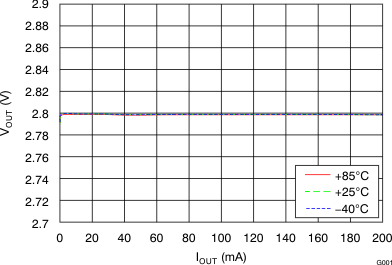
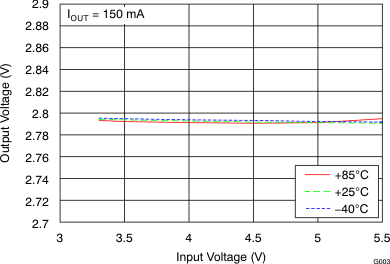
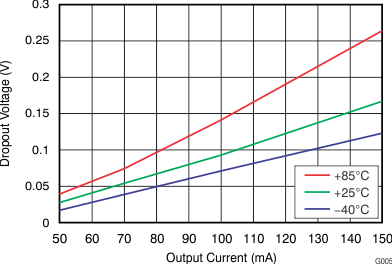
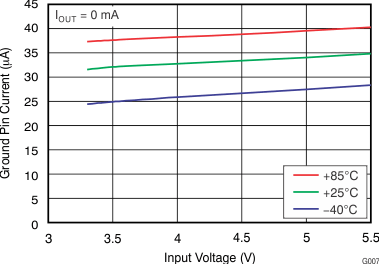
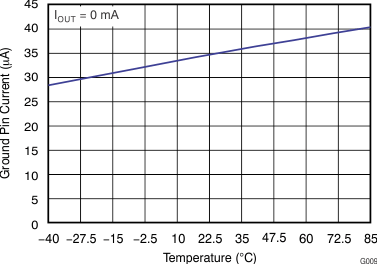
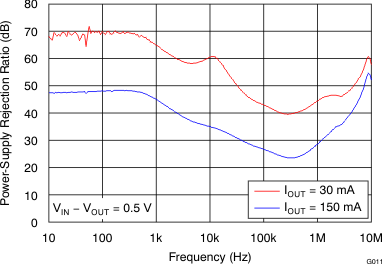
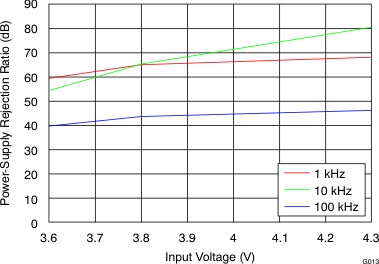
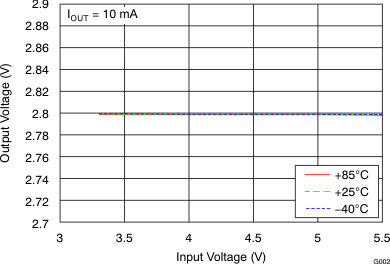
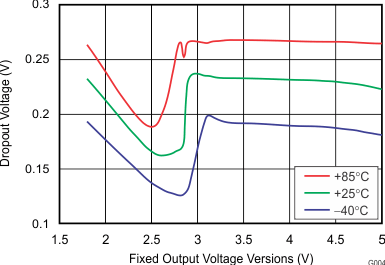
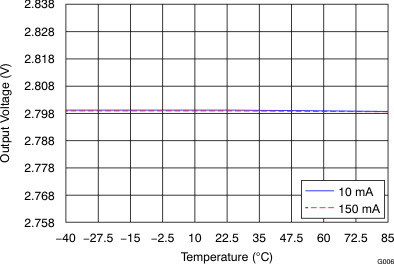
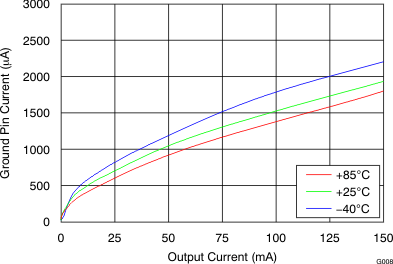
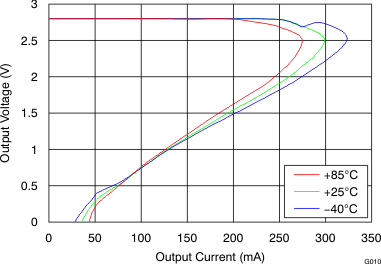
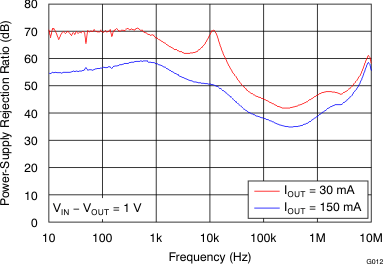
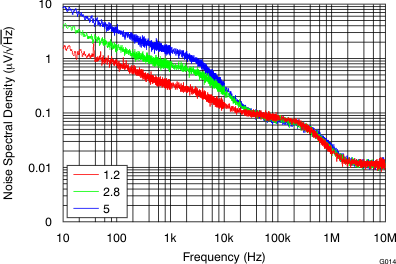
7 Detailed Description
7.1 Overview
The TLV717P belongs to a new family of next-generation value low-dropout (LDO) regulators. These devices consume low quiescent current and deliver excellent line and load transient performance. These characteristics, combined with low noise, very good PSRR with little (VIN – VOUT) headroom, make this family of devices ideal for RF portable applications.
This family of regulators offers current foldback. Device operating junction temperature is –40°C to 85°C.
7.3 Feature Description
7.3.1 Internal Current Limit
The TLV717P has an internal foldback current limit that helps to protect the regulator during fault conditions. The current supplied by the device is gradually throttled down as the output voltage decreases. When the output is shorted, the LDO supplies a typical current of 40 mA. Output voltage is not regulated when the device is in current limit, and is VOUT = ILIMIT × RLOAD. The advantage of foldback current limit is that the ILIMIT value is less than the fixed current limit. Therefore, the power that the PMOS pass transistor dissipates [(VIN – VOUT) × ILIMIT] is much less.
The TLV717P PMOS pass element has a built-in body diode that conducts current when the voltage at OUT exceeds the voltage at IN. This current is not limited, so if extended reverse voltage operation is anticipated, external limiting to 5% of the rated output current is recommended.
7.3.2 Shutdown
The enable pin (EN) is active high. The device is enabled when the voltage at the EN pin goes above 0.9 V. This relatively lower voltage value required to turn the LDO on can be exploited to power the LDO with a GPIO of recent processors whose GPIO logic 1 voltage level is lower than traditional microcontrollers. The device is turned off when the EN pin is held at less than 0.4 V. When shutdown capability is not required, EN can be connected to the IN pin.
7.3.3 Undervoltage Lockout (UVLO)
The TLV717P uses an undervoltage lockout circuit (UVLO = 1.6 V) to keep the output shut off until the internal circuitry operates properly.
7.4 Device Functional Modes
7.4.1 Normal Operation
The device regulates to the nominal output voltage under the following conditions:
- The input voltage has previously exceeded the UVLO rising voltage and has not decreased below the UVLO falling threshold.
- The input voltage is greater than the nominal output voltage added to the dropout voltage.
- The enable voltage has previously exceeded the enable rising threshold voltage and not decreased below the enable falling threshold.
- The output current is less than the current limit.
7.4.2 Dropout Operation
If the input voltage is lower than the nominal output voltage plus the specified dropout voltage, but all other conditions are met for normal operation, the device operates in dropout mode. In this condition, the output voltage is the same the input voltage minus the dropout voltage. The transient performance of the device is significantly degraded because the pass device is in a triode state and no longer controls the current through the LDO. Line or load transients in dropout may result in large output voltage deviations.
7.4.3 Disabled
The device is disabled under the following conditions:
- The input voltage is less than the UVLO falling voltage, or has not yet exceeded the UVLO rising threshold.
- The enable voltage is less than the enable falling threshold voltage or has not yet exceeded the enable rising threshold.
When the device is disabled, the active pulldown resistor discharges the output.
Table 1 lists the conditions that lead to the different modes of operation.
Table 1. Device Functional Mode Comparison
| OPERATING MODE | PARAMETER | ||
|---|---|---|---|
| VIN | VEN | IOUT | |
| Normal mode | VIN > VOUT(nom) + VDO
and VIN > UVLORISE |
VEN > VEN(HI) | IOUT < ILIM |
| Dropout mode | UVLORISE < VIN < VOUT(nom) + VDO | VEN > VEN(HI) | IOUT < ILIM |
| Disabled mode (any true condition disables the device) |
VIN < UVLOFALL | VEN < VEN(LO) | — |
